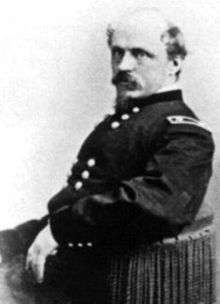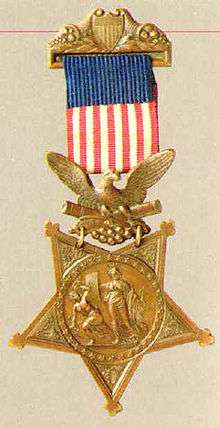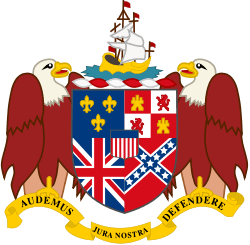Wager Swayne
| Wager Swayne | |
|---|---|
 Medal of Honor recipient | |
| Born |
November 10, 1834 Columbus, Ohio |
| Died |
December 18, 1902 (aged 68) New York City, New York |
| Place of burial | Arlington National Cemetery |
| Allegiance |
United States of America Union |
| Service/branch |
United States Army Union Army |
| Years of service | 1861–1870 |
| Rank |
|
| Commands held |
43rd Ohio Infantry 45th U.S. Infantry Regiment |
| Battles/wars | |
| Awards | Medal of Honor |
| Relations | Noah Haynes Swayne |
Wager Swayne (November 10, 1834 – December 18, 1902) was a Union Army colonel during the American Civil War who eventually was appointed as the last major general of volunteers of the Union Army. Swayne received America's highest military decoration the Medal of Honor for his actions at the Second Battle of Corinth. He also was effectively the military governor of Alabama from March 2, 1867 to July 14, 1868 after the passage of the first Reconstruction Act by the U.S. Congress until Alabama was readmitted to the Union. Robert M. Patton remained the nominal governor during this period but as the local army commander, Swayne controlled the State government.
Biography

Born in Columbus, Ohio, he was the son of Noah Haynes Swayne, Associate Justice of the United States Supreme Court.[1]
He graduated from Yale University and became a lawyer in Ohio.[1]
He served in the Union Army during the Civil War as a field officer in one of Ohio's three-year infantry regiments. In August 1861, Governor William Dennison appointed Swayne as major of the 43rd Ohio Volunteer Infantry Regiment, which was being organized in Mount Vernon, Ohio. He fought at the battles of Iuka and Corinth, and was promoted to fill the vacancy caused by the death of the regiment's colonel.[1]
Swayne led the 43rd Ohio Volunteer Infantry with distinction during the Atlanta Campaign and in the Carolinas Campaign until February 2, 1865 when he suffered a severe wound at River's Bridge, South Carolina on the Salkehatchie River, which resulted in the amputation of his right leg.[1][2]
On March 13, 1865, President Abraham Lincoln appointed Swayne brigadier general of volunteers to rank from March 8, 1865.[3] President Lincoln submitted the nomination to the U.S. Senate on that date and the Senate confirmed the appointment on March 10, 1865.[3]
On May 1, 1866, President Andrew Johnson appointed Swayne as major general of volunteers to rank from June 20, 1865.[4] The President nominated Swayne for the promotion on March 21, 1866 and the U.S. Senate confirmed the appointment on April 26, 1866.[4] This appointment took precedence over his appointment as a brevet major general of volunteers to which grade he had been appointed by President Johnson on January 13, 1866 to rank from October 13, 1865.[5] The U.S. Senate confirmed this appointment on March 12, 1866.[5] He was the last major general of volunteers appointed during the American Civil War period.[1] He also was commissioned colonel of the 45th United States Infantry Regiment. Later, on April 10, 1867, President Johnson appointed Swayne to the grade of brevet major general in the Regular Army to rank from March 2, 1867.[6] The Senate approved this nomination on April 15, 1867.[6] Swayne was mustered out of the volunteer army on September 1, 1867, but stayed in the Regular Army.[2]
After the war, he served as head of the Freedmen's Bureau for Alabama from July 26, 1865 to January 14, 1868.[2] From March 2, 1867 to July 14, 1868, as local army commander, Swayne effectively controlled the State government although Robert M. Patton remained the nominal governor during this period.[1]
Swayne was unassigned as of March 15, 1869 when the army was reorganized and his regiment was consolidated with the 14th U.S. Infantry Regiment.[1] Swayne retired from the army on July 1, 1870.[2] He then moved to Toledo, Ohio, where he established a law practice.[1][2] He moved in 1881 to New York City, where he set up another law practice, specializing in representing telegraph and railroad companies.[1]
In 1893, he was awarded a Medal of Honor for "conspicuous gallantry in restoring order at a critical moment and leading his regiment in a charge" at Corinth.
He died in New York City and was buried at Arlington National Cemetery Arlington County, Virginia, Plot: Section 3, Lot 1406.[1][2]
Medal of Honor citation

Rank and Organization:
- Rank and organization: Lieutenant Colonel, 43d Ohio Infantry. Place and date: At Corinth, Miss., October 4, 1862. Entered service at: Columbus, Ohio. Born: November 10, 1834, Columbus, Ohio. Date of issue: August 19, 1893.
Citation: Conspicuous gallantry in restoring order at a critical moment and leading his regiment in a charge.[7][8]
See also
- List of American Civil War Medal of Honor recipients: Q–S
- List of American Civil War generals
- List of Ohio's American Civil War generals
Notes
- 1 2 3 4 5 6 7 8 9 10 Warner, Ezra J. Generals in Blue: Lives of the Union Commanders. Baton Rouge: Louisiana State University Press, 1964. ISBN 0-8071-0822-7. pp. 490–491.
- 1 2 3 4 5 6 Eicher, 2001, p. 519
- 1 2 Eicher, John H., and David J. Eicher, Civil War High Commands. Stanford: Stanford University Press, 2001. ISBN 0-8047-3641-3. p. 729.
- 1 2 Eicher, 2001, p. 705
- 1 2 Eicher, 2001, p. 715.
- 1 2 Eicher, 2001, p. 709.
- ↑ ""Civil War Medal of Honor citations" (S-Z): Swayne, Wager". AmericanCivilWar.com. Retrieved 2007-11-09.
- ↑ "Medal of Honor website (M-Z): Swayne, Wager". army.mil. Retrieved 2007-11-09.
References
- Eicher, John H., and David J. Eicher, Civil War High Commands. Stanford: Stanford University Press, 2001. ISBN 0-8047-3641-3.
- Warner, Ezra J. Generals in Blue: Lives of the Union Commanders. Baton Rouge: Louisiana State University Press, 1964. ISBN 0-8071-0822-7.
| Political offices | ||
|---|---|---|
| Preceded by Robert M. Patton |
Governor of Alabama 1867–1868 |
Succeeded by William H. Smith |
